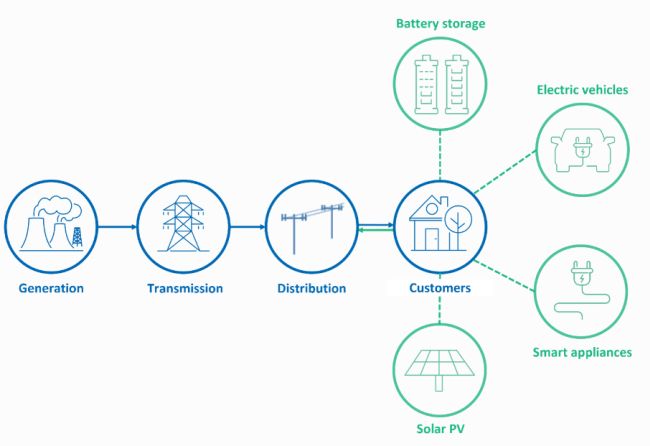A Transforming Energy System
Energy systems around the world, including Australia, are undergoing a transformation in the way that electricity is generated and consumed. Traditionally, energy has been produced by large, centralised generators (such as hydro, coal and gas) and transported to consumers through transmission and distribution networks, as illustrated in Figure 1. Electricity flowed in one direction, and there were few resources to coordinate for the Australian Energy Market Operator (AEMO).

However, Distributed Energy Resources (DER) are shifting the way our electricity systems operate and the role of AEMO in coordinating resources. DER are small-scale resources that can use, generate or store energy at homes or businesses. The most common example is rooftop solar but can also include electric vehicles (EVs), at-home batteries and even smart appliances such as schedulable air conditioning. Energy systems are changing from being centred around large-scale generators to one where thousands of energy resources line the rooftops of modern Australian homes and businesses, as shown in Figure 2.

What does a future with DER look like?
DER has the potential to make energy systems greener, cheaper, and more reliable. If not managed properly, added uncertainty could disrupt reliability and create difficulty in keeping the lights on. In this way, DER is like an orchestra – if everyone plays their instrument at random, the sound is awful. However, when played together, harmony is created. Therefore, a key aspect to understand when considering the impact that increasing DER will have on energy systems is whether resources are active or passive:
- Active DER can change its operation in response to either a market signal or a change in market conditions. For example, a battery located in a person's home can almost instantaneously change whether it is supplying electricity to the house or drawing energy from the grid.
- Passive DER is unable to shift its operation and is restricted to the availability of resources. For example, rooftop solar panels can only generate energy when the sun is shining.
If the flexibility of active DER can be coordinated, it has the potential to support the energy transition by facilitating access to a broader pool of renewable energy, helping to ensure the reliability of the power system, and reducing prices for consumers. However, a lack of coordination of active DER could cause instability within the power system and leave Australia with more hurdles to overcome on the path to net zero.
A perfect harmony
For DER to enhance our energy systems, centralised systems need to be in place to coordinate and control resources on behalf of the asset owners, essentially ensuring that it operates as a single entity. This is often referred to as a 'virtual power plant' (VPP), where lots of energy resources operate as one.
One benefit of this is that DER can reduce the need for emissions-intensive dispatchable generators, such as coal and gas power stations. For example, if there is a shortfall of electricity at a point in time, one household battery won't move the dial. However, if 10,000 batteries can simultaneously provide energy to the grid, it acts in the same way as a large dispatchable generator.
This is similarly true when there is low demand during the day. If demand for electricity from the grid is too low, a VPP operator can increase demand from the grid by charging batteries. During times of very low demand, the coordinated battery fleet can do the job of balancing supply and demand in real-time in response to a system disturbance.
Further, coordinating DER can overcome the challenge of managing electricity demand during peak times. If EVs are set up with the appropriate technology, the software can optimise the charging of vehicles in a way that benefits the power system. For example, an owner may plug in their vehicle when they return home from work and instruct a software that they need a minimum charge of 30% immediately (in case of an emergency trip) but don't need the vehicle to be fully charged until 6 am the following morning. The software would be able to meet these needs by providing an initial charge, but then delaying the remainder until after peak evening demand has subsided.
Synchronising resources
For widespread centralisation of DER to become a reality, asset owners need to be included in the journey by sharing the benefits of a coordinated system. This starts with customers understanding and unlocking the advantages of synchronised energy resources. There are projects all over Australia that are currently embarking on this journey. One example is Project Symphony in Western Australia, which aims to combine rooftop solar, battery storage and major appliances such as air conditioning into a single VPP to provide energy market and network support services to the benefit of electricity consumers.
Given the role that VPPs, and DER more broadly, can provide in making Australia's power systems more reliable, it is critical that policies are put in place to ensure they emerge as a commercially viable and technically efficient solution. To this effect, work is being done to ensure policies and standards are created for DER integration. As part of their post-2025 DER implementation roadmap, the Energy Security Board (ESB) is driving industry coordination to standardise communication between devices, establish frameworks to enable DER to interact with the market and respond to operational signals, and explore how benefits can be fairly shared between consumers.
The content of this article is intended to provide a general guide to the subject matter. Specialist advice should be sought about your specific circumstances.


